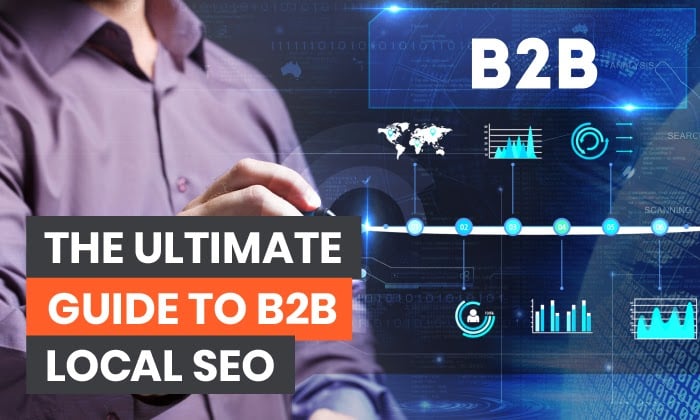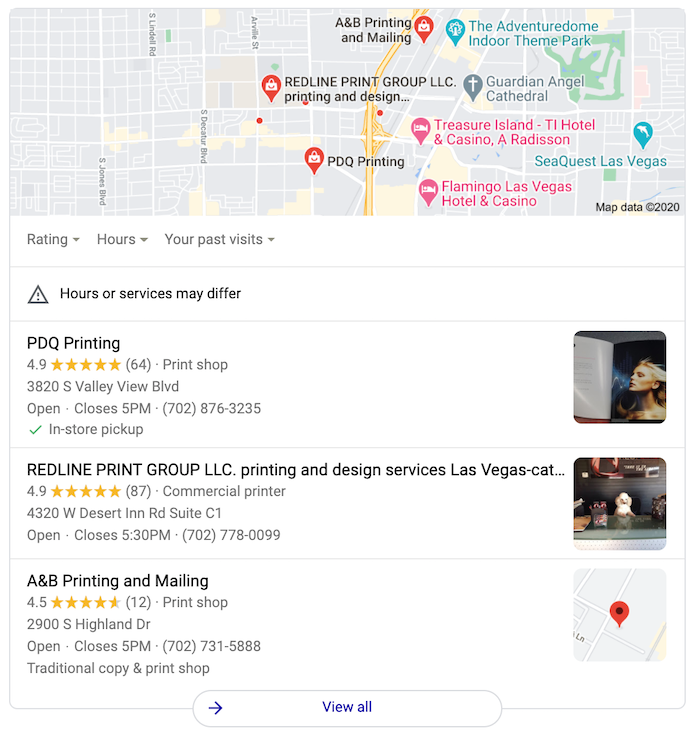
Is your company tapping into its local customers through B2B local SEO?
Although business-to-consumer (B2C) brands often leverage local marketing, business-to-business (B2B) ones tend to take a broader approach.
B2B brands without storefronts are even more likely to have their local marketing strategies slip through the cracks.
That said, there are enormous opportunities for B2B companies to tap into the local market’s power.
46% of all Google searches are local, so if you’re not targeting people in your area, you may be missing nearly half of your potential consumers.
Consumers regularly search online reviews and research businesses in which they’re interested. This trend continues to grow—a BrightLocal study showed 90% of consumers used the internet to find a local business in the last year, with 33% looking every day.
Are you wondering how to attract local customers? The answer is deceptively simple: optimize your local search engine optimization (SEO) strategy.
Let’s dive into critical areas and explore the best ways to enhance your B2B local SEO strategy.
What is B2B Local SEO?
B2B local SEO is about improving your online search visibility for nearby customers in your physical service area.
There are several ways in which local SEO varies from traditional SEO. Several ranking factors can move the needle in different ways.
Some of these include a searcher’s location, your Google My Business listing, online reviews, your website’s mobile optimization, and more.
Begin the process with a B2B local SEO audit. This will help you define which areas need enhancement.
When done right, local search engine optimization will help your website rank higher for specific, relevant searches.
When you rank higher, you become more visible to searchers. Higher visibility in local searches often leads to more sales, leads, conversions, and revenue.
Create and Optimize Business Listings
Once your audit is complete, you can focus on tactics to take your B2B local SEO presence to the next level.
Start the process of optimizing your business for B2B local SEO by getting everything squared away with Google.
First, audit your Google My Business listing. There are several guidelines for representing your business on Google.
Most importantly, to get a Google My Business profile, your company must engage with customers—in person. This means you need a physical address, not a P.O. box or virtual office address. Businesses that travel to customers may also qualify.
This may make it seem like only B2C companies qualify. But, this isn’t necessarily true. Google has an array of categories, and many apply to B2B brands.
Major categories include food establishments, attractions, professional services, personal services, entertainment, retailers, transportation, and more. If you provide any services to companies, your B2C is likely eligible for Google My Business.
The way you represent your business on Google should be consistent with how you showcase your business to the world.
Ensuring all the information on your Google My Business page is accurate is also critical to local SEO for B2B marketing.
When someone searches for your business, if your Google My Business is set up correctly, your listing appears in a box on the right side of Google’s search results.
It contains all the basics about your business, along with reviews. If you don’t fill out your address, phone number, website, and hours, local customers won’t find you as easily.
Then, there are the results that appear at the top of a Google search when someone searches for something more general, like “printing services in Las Vegas.”
Ahrefs refers to these as “snack pack” results.
The “snack pack” box displays the top local business listings most relevant to the search, along with a map showing where each is located.

Google’s customer reviews are also vital. They help increase transparency and establish trust in your brand. You can also gain a lot of insights into your customers’ perceptions through them.
Both positive and negative feedback can tell you a great deal about how your business is faring in the “real world.” Use these reviews to improve your business.
Content Marketing and B2B Local SEO
Creating content is a great way to optimize for B2B local SEO. You want people to find you quickly, and there are many ways to get your business on page one of Google fast.
Perhaps most importantly, you need to use specific keywords related to your industry, products, and area of expertise.
When people search for those terms, your website is more likely to show up if you included them.
Your homepage should clearly illustrate your business. Your “About” and “Contact Us” pages should also feature details your customers may want to know.
This goes for both front- and back-end content. Your title tags, header tags, and meta descriptions should also contain vital information about the business.
Conduct keyword research and determine which ones make the most sense for your business.
The keywords should be contextually relevant and make sense for the audience you’re targeting. In other words, quality matters over quantity.
Ensuring your keywords fit from a regional perspective is also important for b2b local SEO.
While using broad keywords may drive traffic, those visiting may not be the most suitable leads based on location.
This is where strategizing for local customers comes into play.
By integrating region-specific keywords—like city or landmark names—into your content, you’ll be better able to connect with the relevant audience in your area.
Think about how you can give value to this audience in particular. What might they, specifically, be searching for? Create content answering the questions they commonly ask.
Create such content in either written or video form—or a mix of both. Video content is becoming more expected by audiences.
Research by Valasys Media suggests visual storytelling may benefit B2B marketers because:
- It simplifies content for the users.
- It conveys lots of information quickly.
- It strikes a more emotional chord with prospects.
- It improves personalization and invokes a perceived “personal value.”
- It’s often timeless.
Take your region into consideration when creating your stories. How wide should you cast your net? Are you targeting a city or a whole state?
Additionally, research the most effective local base to target for the best ROI.
Link Building and B2B Local SEO
Link building is another pillar of local content marketing strategy. We touched upon link categories before, and they come into play with link building.
If possible, garner links back to your website and digital assets from a variety of local sources.
These may include local directories, industry-related sites, partner sites, chambers of commerce and other organizations, and newspapers’ sites.
A great way to have other sites link to you is to create and promote a useful resource. For example, say you’re a local medical clinic that provides flu shots to businesses, and flu season is approaching. You could create a guide about the best ways to avoid the flu at the office.
This type of guide is something from which anyone can learn, and it’d be beneficial for other sites to feature it.
Many chambers of commerce websites also have areas where local businesses can promote offers.
For example, the Newport Chamber of Commerce has a specials page where various B2B brands like office space and printing services offer deals.
Mobile Marketing and B2B Local SEO
Mobile marketing is a critical aspect of B2B local SEO, as 50% of B2B search queries are from mobile devices.
Since people have their phones with them all the time, they’re able to search more proactively than in the past.
Search Engine Journal compiled some fascinating stats on mobile search trends related to local SEO. Did you know 18% of local mobile searches lead to a sale within one day? Or that 78% of local-based searches on a mobile device end in purchases made offline?
Keep these mobile trends in mind when boosting your local online presence. Make sure your website and landing pages are optimized for mobile devices.
Your digital strategy for B2B local SEO should also include social media, which is primarily accessed through mobile devices. Facebook and Instagram have local components that let you include instructions and allow customers to geo-tag your business when they post about it.
There are many ways people search for businesses on their smartphones. This is why having your Google My Business listing up to date is imperative.
Whether your customer is planning in advance or already on the way, you want to make sure to reach them wherever they are.
The Benefits of B2B Local SEO
Why is b2b local SEO important? Because you have a greater potential of driving in-person traffic to your business when you target your local audience.
For a relatively low-cost, you can draw in people who are searching for your type of business.
Diversifying your online presence across various channels has further benefits as well. Many third-party websites and platforms like Yelp, TripAdvisor, and other similar directory-like sites are becoming more advanced.
They also have their own audiences, who wouldn’t find you as easily if those directories are their go-to search options.
In addition to maximizing your presence on Google and other websites, optimize your website for local search.
For example, if you’re a dog groomer in San Diego, integrate keywords like “dog groomer in San Diego” so you have specifically mentioned your location.
When people in your region are conducting local searches for “dog groomers near me,” you’ll rank for those, too—but only if Google knows where you’re located.
The key to ranking for “[your term] near me” is to start by Googling that specific phrase or your local-specific phrase that you want to rank for.
When you do that, you’ll be able to see all the localized sites from which Google is pulling. Make sure you’re listed there—if you’re not, you need to figure out why. Have you made your location clear?
If you live in Boston, for instance, there are many suburbs, landmarks, etc. On your website, list different nearby features like these. It could also be beneficial to include directions to your business from those specific places.
Ensure you also have a localized number and not just an 800 number, so people know you’re really there.
Furthermore, when people look for a specific service, they’ll often visit various touchpoints.
For instance, they may land on your website and then go to Yelp to read reviews. This is why having a listing there is essential.
After providing services, ask customers to leave reviews.
Conclusion
Local businesses can hugely benefit from strategic SEO plans.
Think about how many people use their mobile devices to search for local businesses.
There are many ways to get your business found online, from keyword optimization to link building tactics and local listings.
Which b2b local SEO tactics have been most fruitful for your B2B business?
source http://feedproxy.google.com/~r/KISSmetrics/~3/HvX-N11FN20/
No comments:
Post a Comment